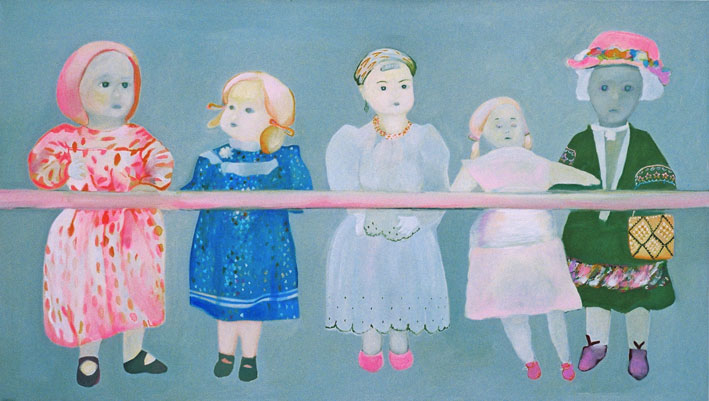At first glance, the main figurative motives of the works collected for this project, entitled LOVE AND DESIRE, are closely linked to the world of childhood, its innocent games, burgeoning imagination, a child’s uninhibited need for love, to the world of great hopes and its optimistic expectations. The playing children, children’s toys, as well as the game itself, are here, however, as merely a cause for me to continue my extended preoccupation with the problems of utopia, love, longing and alienation, solitude, decadence, but also of destruction in the modern globalist world.
‘The idea for the series of works about LOVE AND DESIRE was born during an accidental, so to speak, visit to the Toy Museum in Salzburg. It turned out that the museum’s collection consisted mainly of children’s toys from the years immediately preceding the Second World War. I was particularly fascinated by the dolls, their facial expressions, their positions and their energy. They reflected emotions of fear, uncertainty, seriousness and concern, so inappropriate for the child’s world, as if the dolls themselves had given a hint of the, then, approaching tragic war years. But more and stronger than that, these dolls, placed in an “idyllic space” of the museum of children’s games of the past century, impelled me to establish an immediate connection between the age of their creation and today. Their faces were not unfamiliar to me: they vividly reminded me of the contemporary facial expressions – of many random passers-by, but also of my close friends. The dolls’ faces mirrored the anxiety and anguish, the wondering about the senseless wars and the destruction of the planet’s natural resources, as well as the feeling of loneliness and growing alienation – a paradoxical result of the universal digital “networking” through the Internet at the beginning of the new millennium.
Having lived from 2008 to 2011 between Venice, Paris and Belgrade, I have had a chance to observe and compare to what extent the modern global society is overwhelmed and intersected by the harsh contrasts of misery and, far too often, the false glamour and general eccentricities. In the world’s great capital cities, as living “civilisation museums“, there are streams of the homeless and tourists flowing in parallel. Both streams are drawn to the same, childishly innocent and naive goal – the utopian dream of Paradise, symbolizing eternal pleasure and love. The photographs of the scenes, which initially evoked my memories of childhood and pictures from fairytales, essentially dealing with the alienation and solitude of man in the modern world, were an immediate incentive for the creation of the group of works dedicated to our era and its perspectives. Has “THE LOVE” become a utopia today, or is its substitute – “THE LONGING FOR LOVE”, solely the last tangiable remnant of the utopian dream about an ideal world, these are the questions that I am trying to answer in these works.’





